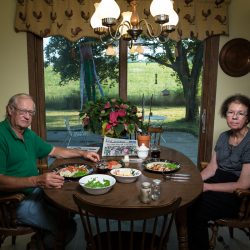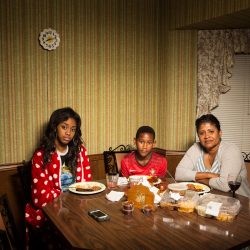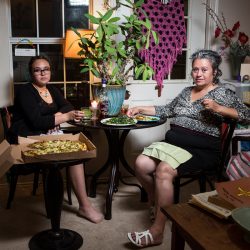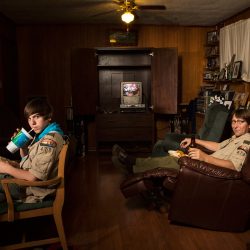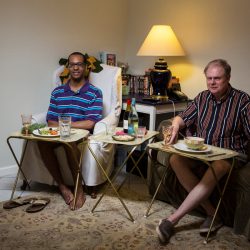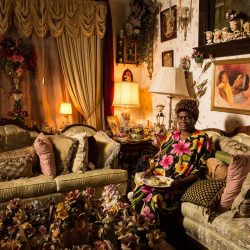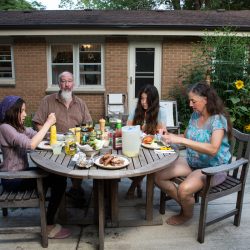This American photographer captured a series of ordinary American family dinners and let all the photos speak for themselves
People today see ‘food’ as more than just something one consumes in order to survive. Food reflects the economic and social status of an eater, cultural characteristics defined by places and time and religious beliefs. art4d is reminded of a project by a Chinese-Singaporean artist who traveled to 36 countries around the world to study the daily minimum wage that the lower classes in different areas were able to make and the money they spent on purchasing food. A series of photographs was taken, capturing the poor people’s menus in different parts of the world, depicting the gap between the poor (in each country) while exemplifying the relationship between photography and food that goes far beyond the commercial aspects.
In a similar direction, Weeknight Dinners, a project by American artist, Lois Bielefeld, is a series of 78 photographs that record activities on the dining table of American and Luxembourg families. “I began with the people I know, someone who used to work with me on the same project. Sometimes I would put up posters on announcement boards and post ads online as well.” Weeknight Dinners is not the first project that Bielefeld has carried out that required working with a large number of people. From 2008 onward, she worked on several projects where she took portraits of people in different postures at various places. The Bedroom (2008-2012) is a series of portraits of 107 Americans, from male and female to the young and the old, all taken in their own bedrooms. Lunch Portraits (2010 – 2012) was taken when Bielefeld was working in a studio and started to notice that many of her colleagues (herself included) brought their own lunch boxes to work. She then set up a corner in the office to serve as a photography studio where she took portraits of her coworkers with their lunches, consequentially creating a series of 71 lunchtime portraits. For On Faith (2015), Bielefeld changed the subject and setting to churchgoers. It was a work created during her 10 days serving as an artist-in-residence in Bourglinster, Luxembourg.
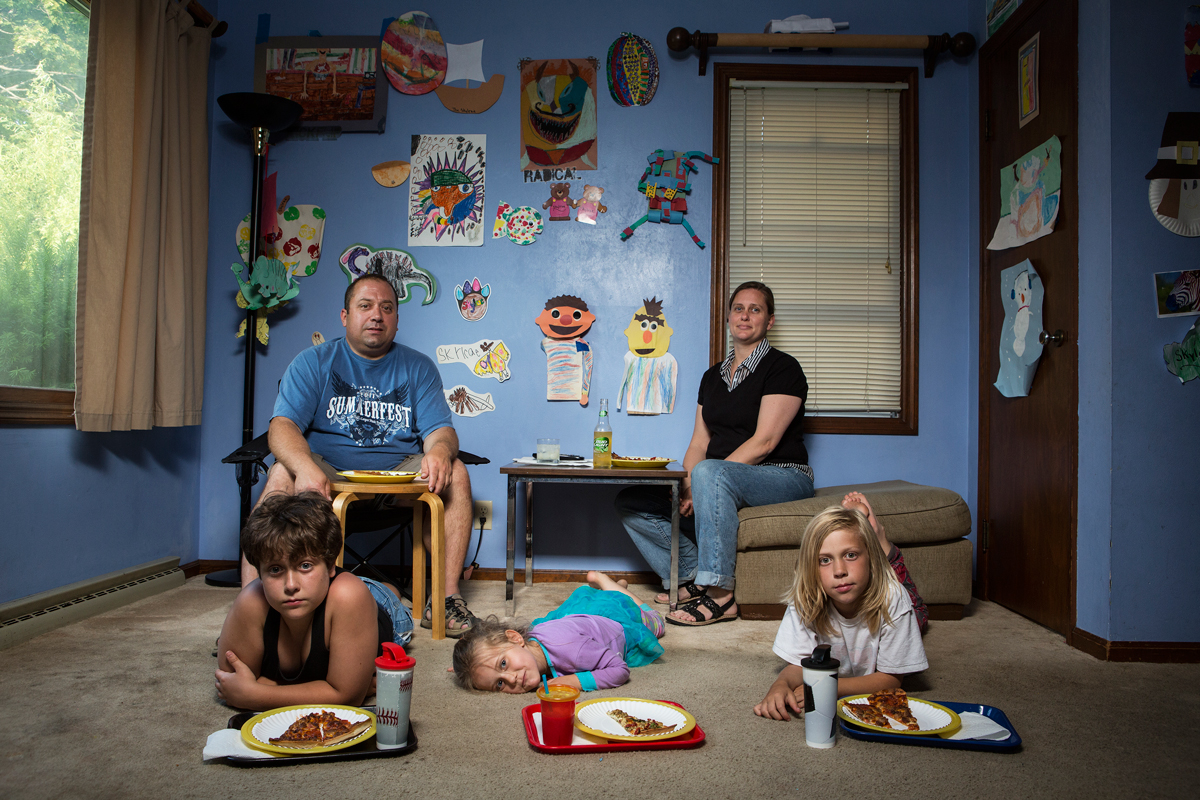
Apart from the time-based approach that influences the number of photographs and repetitive compositions and turns Bielefeld’s work into a documentary with its own subject (the documentary element of the work is also one of the things Bielefeld is interested in and she personally told art4d through our email interview that she has always loved to cook since she was a child. To her, food has a direct connection with culture.) “The desire to eat has become more complicated when there’s culture, rituals and routines involved, whether it’s the meaning of food or one’s decision to eat or not to eat something.” The United States, in particular, while possessing the ideal image of liberalism and freedom, has, from the past, developed a very strong tradition or ‘ideal’ when it comes to food, the tradition being a home-cooked meal served on a round table with all the family members present. It is during dinner that everyone shares the stories they came across that day. But such tradition is being challenged by new forms of food (such as ready-toeat, frozen and delivery meals), the changes in people’s ways of life, and the extended period of time people spend commuting between their homes and offices in the city, which has caused the weekday dinners, especially from Mondays to Thursdays to lose their significance.
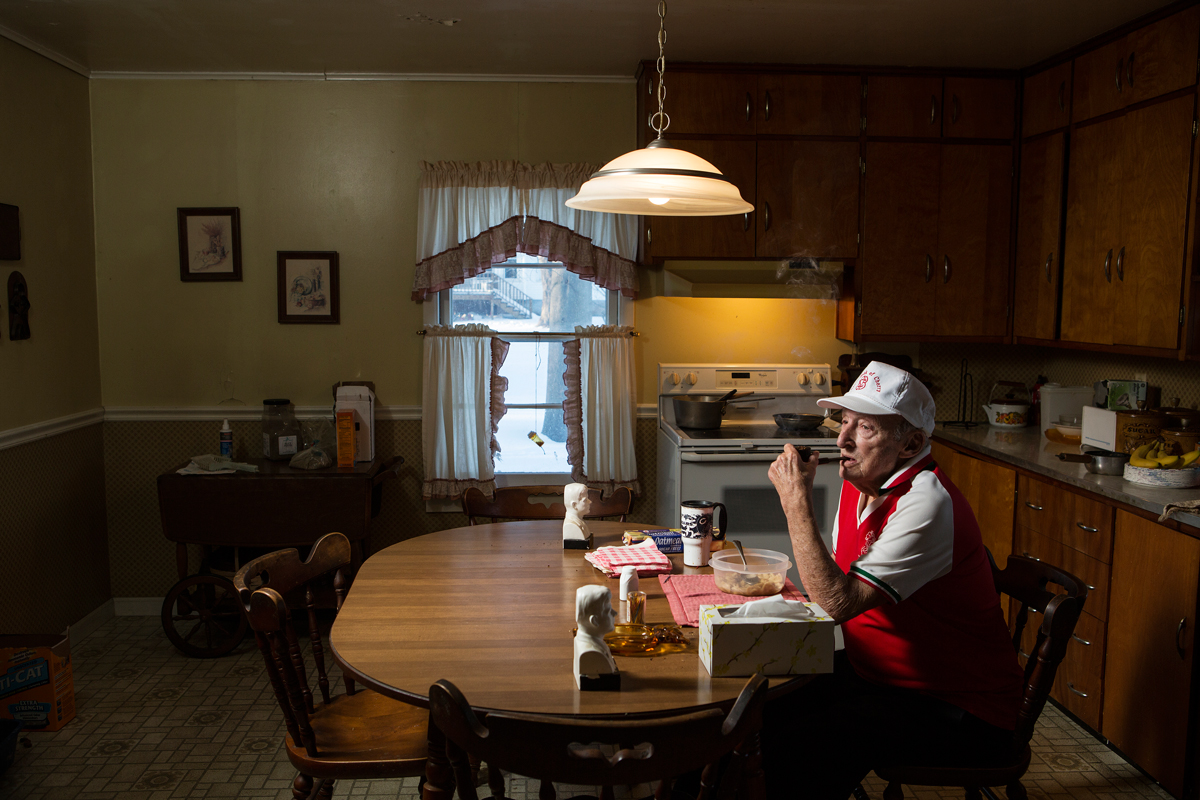
/ PEOPLE TODAY SEE ‘FOOD’ AS MORE THAN JUST SOMETHING ONE CONSUMES IN ORDER TO SURVIVE /
Weeknight Dinners is a project that Bielefeld uses to explore the evening meal behaviors of modern American people. The program she set out for the project was to capture a typical meal at home on Monday through Thursday evenings. “I’m interested in the differences between reality and the ideal image so I asked them to prepare the meal like they usually do with nothing special.” The reality she came across during the process was that a lot of big families still sit and eat together at a dinner table, but each household has its own different rituals and there is a number of families that don’t necessarily eat at a dining table but a small TV table next to the sofa, while some sit on the carpet in front of a television. They don’t always eat home-cooked food, with pizza and hamburgers being among the most popular choices. Some go with a microwaved meal that comes in a plastic box. She also photographed a senior gentleman having his meal alone in the kitchen and a young man staring at his computer while eating his dinner.
What’s interesting are the viewers’ interpretations when the photographs are put together into an exhibition. Bielefeld told us that during early 2017 when Weeknight Dinners went viral, she received an incredible mix of opinions from the people who saw her work. Some viewed the image of an old man having his meal in front of a television as a toxic result of the capitalist economy that lessened the importance of family. Some criticized parents who let their children eat their dinner on the floor in front of a television as inappropriate, saying that they would never let their children do the same. “Weeknight Dinners brings out people’s online behaviors and the ways they impose their own sets of standards (incubated by the culture they grew up in) and judge the people they see in the photographs.” The reason that causes most viewers to look past the meal to family routines captured in Bielefeld’s photographs is because there are more descriptions to those moments. In other words, while Weeknight Dinners’ main subject is the meals people eat on the weeknight evenings, visible in these photographs are the interior of the kitchen, decoration style of their homes, their facial expressions and gestures that imply their relationship statuses.

ทุกวันนี้เรามอง “อาหาร” เป็นมากกว่าของกินที่ต้องกินเพื่อมีชีวิตรอด แต่เป็นสิ่งที่สะท้อนถึงอะไรต่อมิอะไรได้มากกว่านั้น ไม่ว่าจะเป็นฐานะของผู้กิน วัฒนธรรมแต่ละสมัย และความเชื่อทางศาสนา ก่อนหน้านี้ art4d เคยเกือบได้ตีพิมพ์โปรเจ็คต์ของศิลปินชาวสิงคโปร์เชื้อสายจีน ที่ตระเวนไปทั่ว 36 ประเทศ เพื่อศึกษาสถิติรายได้ขั้นต่ำต่อวันของคนจนในแต่ละพื้นที่ ก่อนจะเดินเข้าตลาดไปหาซื้ออาหารเท่าที่รายได้ต่อวันของพวกเขาจะซื้อได้ และเอามาถ่ายเป็นชุดภาพเมนูอาหารคนจนของแต่ละพื้นที่ นอกจากงานชิ้นนี้จะทำให้เราเห็นความเหลื่อมล้ำระหว่างคนจนด้วยกัน (ในแต่ละประเทศ) มันยังเป็นตัวอย่างที่ดีที่แสดงให้เห็นว่าความสัมพันธ์ระหว่างภาพถ่ายอาหารเป็นได้มากกว่าการถ่ายภาพในเชิงการค้า
ในทิศทางเดียวกันกับโปรเจ็คต์ Weeknight Dinners โดย Lois Bielefeld ศิลปินอเมริกันที่เป็นซีรีย์ภาพกิจกรรมบนโต๊ะอาหารเย็นของชาวอเมริกันและลักเซมเบิร์กกว่า 78 ภาพ “เราเริ่มจากคนที่รู้จักคนที่เคยทำโปรเจ็คต์ด้วยกันมาก่อน บางครั้งก็หาจากข้างนอกทั้งติดโปสเตอร์ตามบอร์ดประกาศและโพสต์หาทางออนไลน์” Weeknight Dinners ไม่ใช่โปรเจ็คต์แรกที่ Bielefeld ทำงานร่วมกับคนจำนวนมาก ตั้งแต่ปี 2008 เป็นต้นมาเธอทำโปรเจ็คต์ภาพถ่ายพอร์ทเทรตผู้คนในอิริยาบถและในสถานที่ที่แตกต่างกันอยู่หลายโปรเจ็คต์ เช่น The Bedroom (2008 – 2012) ภาพพอร์ทเทรตคนอเมริกัน 107 ภาพ ทั้ง ผู้ชาย ผู้หญิง เด็ก ผู้ใหญ่ คนแก่ ในห้องนอนของเขาเหล่านั้น Lunch Portraits (2010 – 2012) ที่ถ่ายขึ้นขณะที่ Bielefeld ทำงานอยู่ในสตูดิโอแห่งหนึ่ง และสังเกตเห็นว่าเพื่อนร่วมงานหลายๆ คน (รวมถึงตัวเธอเอง) มักจะนำอาหารกลางวันมากินในออฟฟิศ เธอจึงเซ็ตมุมหนึ่งในออฟฟิศขึ้นมาเป็นสตูดิโอถ่ายภาพ และถ่ายพอร์ทเทรตเพื่อนร่วมงานและอาหารที่เขานำมาเป็นชุดภาพถ่ายจำนวนกว่า 71 ภาพ หรือ On Faith ( 2015) ที่เธอเปลี่ยน subject และสถานที่มาเป็นคนในโบสถ์ โปรเจ็คต์นี้ทำขึ้นตอนเธอเข้าร่วมโครงการศิลปินในพำนักเป็นเวลา 10 วัน ที่เมือง Bourglinster ประเทศลักเซมเบิร์ก
นอกจากวิธีการทำงานแบบ time based ที่ส่งผลต่อจำนวนของภาพถ่าย และการจัดองค์ประกอบภาพแบบเดียวกันซ้ำๆ ที่ทำให้ภาพถ่ายของ Bielefeld เป็นเหมือนกับ documentary ในหัวข้อๆ หนึ่ง (นัยของการบันทึกยังถูกเน้นย้ำด้วยวิธีการตั้งชื่อภาพที่ไม่ได้บอกอะไรไปมากกว่าชื่อของบุคคลในภาพ) ประเด็นเรื่อง “อาหาร” ยังเป็นเรื่องที่ Bielefeld สนใจ เและเธอก็บอกกับ art4d ในการสัมภาษณ์ทางอีเมลด้วยว่าเธอชอบทำอาหารมาตั้งแต่เด็กๆ ซึ่งสำหรับเธอแล้วอาหารนั้นสัมพันธ์โดยตรงกับวัฒนธรรม “ความต้องการกินอาหารกลายเป็นเรื่องซับซ้อนมากขึ้นเมื่อมันมาเกี่ยวข้องกับวัฒนธรรม พิธีกรรม และกิจวัตร ทั้งความหมายของอาหาร การตัดสินใจว่าจะกินอะไรหรือไม่กินอะไร” โดยเฉพาะในสหรัฐอเมริกาที่เหมือนจะเสรีนิยมเอาเสียมากๆ นั้นกลับมีธรรมเนียมหรือพูดอีกแบบคือ “อุดมคติ” ในเรื่องของการกินที่แข็งแรงมาตั้งแต่อดีตนั่นคือ ต้องเป็นอาหารที่ปรุงเอง ต้องกินบนโต๊ะกลมพร้อมหน้าพร้อมตากันเพื่อรีวิวเรื่องราวรอบวันของสมาชิกในครอบครัว อย่างไรก็ตาม ธรรมเนียมที่ว่านี้กำลังถูกท้าทายด้วยอาหารแบบใหม่ (อย่างเช่นอาหารสำเร็จรูป หรืออาหาร delivery ) และการเปลี่ยนแปลงของชีวิต การทำงานในเมืองที่ต้องเสียเวลาในการเดินทางไปกลับจนทำให้มื้อเย็นโดยเฉพาะวันจันทร์ – พฤหัสบดี กลายเป็นเรื่องรองที่ได้รับความสำคัญน้อยลงไป
Weeknight Dinners เป็นโปรเจ็คต์ที่ Bielefeld ใช้สำรวจพฤติกรรมการกินอาหารเย็นของคนอเมริกันสมัยนี้ เธอตั้งโปรแกรมการถ่ายรูปไว้ว่าจะถ่ายภาพมื้ออาหารเย็นของวันจันทร์ – พฤหัสบดี และต้องเป็นมื้ออาหารในบ้านเท่านั้น “เราสนใจความแตกต่างระหว่างความเป็นจริง / อุดมคติ จึงขอให้พวกเขาเตรียมอาหารแบบปกติที่เขากินกันแบบที่ไม่ต้องจัดเตรียมเป็นพิเศษ” เธอกล่าว และความจริงที่เธอพบระหว่างการถ่ายภาพก็คือ มีหลายครอบครัวยังคงกินข้าวพร้อมกันอยู่ อย่างไรก็ตาม แต่ละครอบครัวก็มีวิธีการกินที่ต่างกันไป และจำนวนหนึ่งนั้นไม่ได้กินบนโต๊ะกินข้าว แต่เป็นบนโต๊ะเล็กๆ ที่ถูกเลื่อนมาติดกับโซฟา กินบนพรมหน้าทีวี ส่วนอาหารก็ไม่ได้เป็นอาหารที่ปรุงเอง เห็นได้บ่อยครั้งว่ามันเป็นพิซซ่า แฮมเบอร์เกอร์ ไม่ก็อาหารสำเร็จรูปที่บางส่วนยังเหลืออยู่ในกล่องพลาสติกบางภาพเป็นคนแก่กินอาหารคนเดียวในห้องครัวหรือหน้าคอมพิวเตอร์
ที่น่าสนใจคือการตีความของผู้ชมเมื่อภาพถูกจัดแสดง Bielefeld เล่าว่าช่วงต้นปี 2017 ที่ Weeknight Dinners กลายเป็นไวรัลแพร่กระจายไปบนอินเตอร์เน็ต เธอได้เห็นความคิดที่แตกต่างกันไปจากคนดู บางคนมองภาพคนแก่ที่กินข้าวคนเดียวอยู่หน้าทีวีว่าเป็นพิษของเศรษฐกิจแบบทุนนิยมที่ทำให้สถาบันครอบครัวถูกลดทอนความสำคัญลงไป บางคนวิจารณ์ว่าการเลี้ยงดูของพ่อแม่ที่ปล่อยให้ลูกๆ กินข้าวกับพื้นหน้าทีวีนั้นไม่เหมาะสม และประกาศว่าตัวเองไม่ปล่อยให้ลูกกินข้าวแบบนั้นแน่ๆ “Weeknight Dinners ทำให้เราเห็นพฤติกรรมของทางฝั่งคนดูด้วย มันคือนิสัยการเอาบรรทัดฐานของตัวเอง (ที่ก็ถูกปลุกปั้นจากวัฒนธรรม) มาตัดสินพฤติกรรมคนอื่นในภาพนั้น” สาเหตุที่ทำให้คนดูมองเลยมื้ออาหารไปถึงกิจวัตรภายในครอบครัวเป็นเพราะภาพถ่ายใน Weeknight Dinners มีจุดบรรยายในภาพมากกว่าหนึ่งจุด หรือพูดอีกแบบก็คือ ถึงแม้ประเด็นหลักของ Weeknight Dinners จะคืออาหารที่เขาเหล่านั้นกินในคืนวันธรรมดา แต่ภาพถ่ายก็โชว์ให้เห็นอินทีเรียของห้องครัว รสนิยมการแต่งบ้าน ไปจนถึงสีหน้าท่าทาง อากัปกิริยาของคนในภาพที่หลายๆครั้ง ทำให้เดาได้ไม่ยากว่าอยู่ในสถานะความสัมพันธ์แบบไหน
ที่น่าสนุกไปกว่านั้นคือความจริงที่ว่าขณะที่หลายๆ คนเผลอตัวตีความเลยเถิดไปเกินภาพนั้น ภาพบางภาพมันกลับเป็นฉากที่ถูกเซ็ตขึ้นมา นี่เป็นอีกเรื่องที่ศิลปินควบคุมไม่ได้ เธอเล่าว่ามีอยู่หลายครอบครัวที่เตรียมอาหาร (บางคนถึงกับทำไก่อบกินกันในวันนั้น) จัดบ้านและแต่งตัวเรียบร้อยเป็นพิเศษ เมื่อรู้ตัวว่าวันพรุ่งนี้จะมีช่างภาพเข้าไปถ่ายภาพ ซึ่งก็ไม่ได้เป็นเรื่องแปลกเพราะเธอเข้าใจดีว่าเป็นธรรมดาที่ทุกคนอยากจะนำเสนอตัวเองในด้านดีให้คนอื่นเห็น ตอนนี้ Bielefeld เป็นศิลปินในสังกัด Portrait Society Gallery แกลเลอรี่ในสหรัฐอเมริกา ภาพถ่ายชุดล่าสุดของเธอมีชื่อว่า Neighborhood ซึ่งคงเดากันได้ว่าคราวนี้เธอออกไปถ่ายกิจวัตรประจำวันของบรรดาเพื่อนบ้านในบริเวณใกล้เคียง ที่พิเศษคงเป็นเพราะในครั้งนี้ บางส่วนของภาพในซีรีย์เป็นกิจวัตรของคนลักเซมเบิร์กซึ่งคงทำให้เห็นไลฟ์สไตล์ที่แตกต่างกันระหว่างคนอเมริกันและลักเซมเบิร์ก ต้องรอดูว่าผลงานต่อๆ ไปเธอจะเป็นอย่างไร
TEXT : NAPAT CHARITBUTRA
PHOTO COURTESY OF LOIS BIELEFELD
loisbielefeld.com


